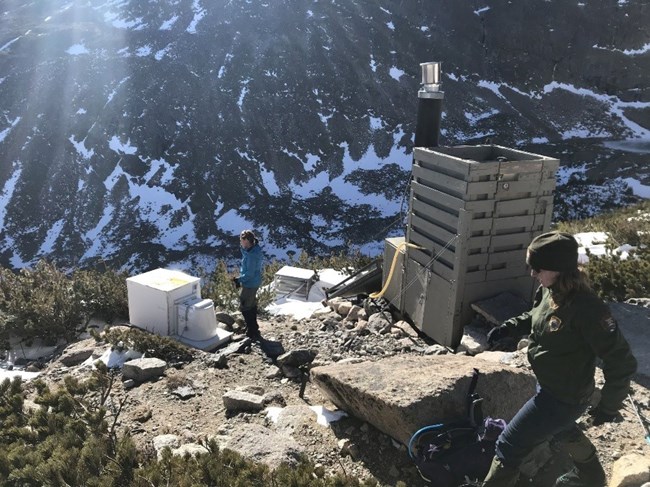Last updated: June 16, 2020
Article
2018 Engineers Week: Marina Connors, Park Engineer, Rocky Mountain National Park

Image courtesy Marina Connors.
Tell me about the most challenging engineering project you have been involved with in the recent past.
I’m currently working on a project to replace some bathroom facilities at Longs Peak and Gem Lake. This project will replace five failing solar toilets with new waste diverting toilets with the goal of improving the visitor experience and resource conditions, while reducing park maintenance and improving employee safety. The sites are only accessible by foot, mule, llama or helicopter. They are all in designated wilderness areas and all but one is at an elevation above 11,550 feet, at sites with high wind speeds. The design of the toilet does not neatly fit into a category in any of the regulations associated with wastewater systems, making the construction approval process a challenge. Additionally, balancing the wilderness act and natural, cultural, and accessibility requirements with design and constructability of the toilets is additionally difficult.
What checks and balances do you use to make sure your project meets Park Service's needs while staying within available funding and specified time frames?
I schedule a monthly review of all the projects I’m responsible for managing, including a review of budget and schedule. I’ve developed a project tracking sheet which is updated monthly and hangs in clear view of my desk for quick reference. The monthly review includes staff in my work group as to get input from the project leads. All projects require coordination with other divisions, so, as needed, I meet with other divisions to make sure that the work their division needs to do in relation to the project (i.e. revegetation, cultural compliance) aligns with the project budget and schedule. However, budget and schedule are factors of a project that are constantly a consideration throughout the design process, not only at a scheduled monthly review.
What are you doing to stay current with the latest technology?
I am on several email lists within the Park Service, vendors, and professional groups. As time permits, I review these emails and focus on topics of interest. I search topics on the internet which is the most frequent resource I go to. I prefer webinars to classroom training and appreciate how many webinars are free and don’t require travel or entire days away from keeping up with my workload. About once a year, I try and participate in a classroom training which is specific to a topic that I don’t think will be effectively learned on-line. Finally, when there is a something specific I need to learn about in relation to a project, I’ll pick up the phone and talk to peers, representatives and vendors who educate me.
What does a typical day look like for you?
I usually start by checking email and then review my top priorities for the day while working to stay focused on specific “to do” items. Now that I’m working in a park, rather than a regional office, I find much of my time is spent coordinating with other divisions, including: budget, cultural resource specialists, natural resource specialists, trails crews, building and utility specialists, public information officers, housing specialist, etc. Not only am I working on getting projects to contracting, I am making sure the project “works” for all divisions in the park, throughout design, construction and finally, once it’s done. I do much of my work in my office, but also spend time out in the field to scope projects, coordinate with other divisions and oversee construction.
What do you enjoy most about your job as an engineer?
I enjoy the challenge of figuring out how to improve our facilities. I find that working for the Park Service, no two projects are alike. They all have their unique challenges. Often, projects have so many challenges, from defining the scope, to compliance, to design, to contracting, to construction, to operation, that it’s hard to believe that the project will actually be completed. So when it is done, I love the feeling that despite the challenges, I helped improve our infrastructure.
